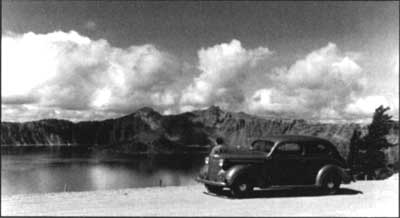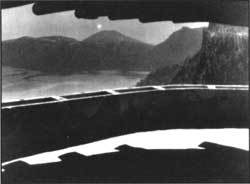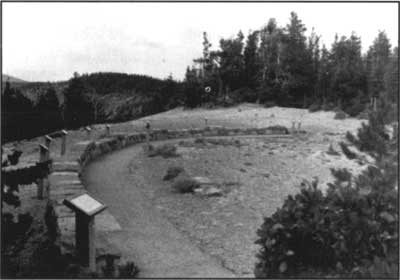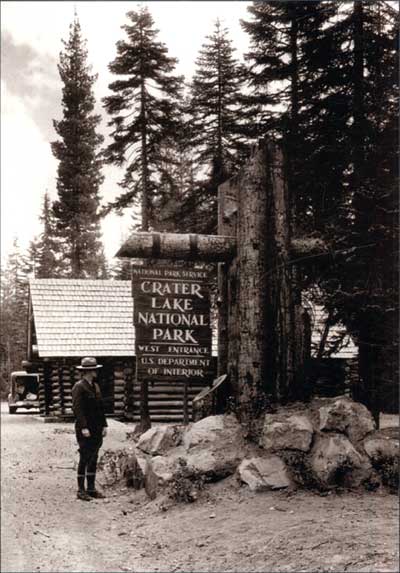|
Volume XXIX - 1998
Victor Rock and Victor View
By Steve Mark
Throughout the summer a number of visitors come to the information
desk at Park Headquarters asking about the best place to see Crater
Lake. These people have convinced themselves that they have only an hour
or so to spare in the park, and then want to be on their way to
somewhere else. I routinely dodge this type of query, if only because
they have not yet seen the lake. This makes it impossible to communicate
where around the rim a person could best appreciate that wonderful
combination of color, geological features, and subalpine vegetation
which has prompted more than one person to describe Crater Lake as the
most beautiful thing they have ever seen in nature.
For those who are so short on time, and wish to limit their
experience to one which involves little or no contemplation, any lake
viewpoint between Park Headquarters and the North Junction will do.
Motorists soon find that more than one stopping point allows them to
stay in their vehicle and still see Crater Lake. They will, however,
find it difficult to appreciate their surroundings without a good
guidebook at the very least.
The Mazamas, a mountaineering club based in Portland, published the
first booklet aimed at enhancing visitor enjoyment of Crater Lake in
1897. It had limited availability, so the government began to print
pamphlets and maps with some explanation of the park's geology. These
devices still fell short, it seemed, of allowing the non-scientist to
fully comprehend what lay before them. Trained naturalists began
lecturing and guiding the public in Crater Lake National Park during the
summer of 1926, but the question of how to best convey the park story
remained. After some study, park officials decided to focus most of
their educational program at Rim Village because of its proximity to
what had long been the most popular viewpoint at Crater Lake.

Visitor near Victor View in the late
1930s.
Named in honor of a historian who visited the lake in 1872, Victor
Rock appears to be precariously perched some 900 feet above the water.
The Sinnott Memorial was situated over this viewpoint in 1930, so that
naturalists might give a brief orientation talk from an open-air parapet
on a regular basis throughout the summer. Certainly no classroom, nor
any other facility situated away from the rim, can equal the Sinnott
Memorial as a venue to both see and hear about Crater Lake for the first
time. It continues to function as an observation station aimed at
enticing visitors to explore the park, in the hope that what they
experience here will fuel an ongoing fascination with the forces which
continue to shape the earth.

The sinnott memorial's parapet as it appeared iin
1933. NPS photo by George Grant.
|
To broaden the introduction given by naturalists in the Sinnott
Memorial, park officials initiated an educational boat tour of Crater
Lake in 1931. That year they also began a project which was to widen and
realign Rim Drive. In addition to making the road safer, designers
focused on showing motorists many important park features. In order to
accomplish both goals, masonry walls and the resulting series of
observation stations were built to blend into their surroundings. Just
as the Sinnott Memorial is virtually invisible from the surface of
Crater Lake, the Rim Drive is intended to facilitate contemplation of
the lake, cliffs, and forest by minimizing road scars that can be seen
at a distance. Far from being the cookie cutter pull outs which often
characterize modern road design, each of the observation stations was
intended to help visitors see the park in different ways -- as anyone
who has been to such divergent stops as Discovery Point, Grotto Cove,
Skell Head, and Kerr Notch will attest.
The East Rim Drive in particular remains much as its designers left
it, while also being largely free of the noise and crowds which often
dominate the through route from Rim Village to the North Junction. With
the notable exception of the Cleetwood Cove parking area (where people
have gathered almost every summer day since 1960 for hikes down to the
lake and a boat tour), visitors who pause along this 24 mile road
segment should have few distractions -- especially if they are inclined
to walk even a short distance. In nominating a favorite stop along this
stretch of road, my choice is based on the following subjective
combination of factors. These include the predominance of quiet, an
opportunity to hike, the attractive contrast of subalpine vegetation
with open slopes, authentic examples of stone masonry from the 1930s
(original work can be identified from mortar joints which feature some
lichen growing on them), and, of course, the sublime drama of Crater
Lake.
With those criteria in mind, my choice is a place known as Victor
View. It does not appear on some maps, though the name became official
in 1945. The park superintendent at that time found very few people who
could identify the rock named for Mrs. Victor, even though thousands of
visitors came to the Sinnott Memorial each summer. Victor View is an
observation station located between Cloud Cap and Kerr Notch, but has
not been signed as such. Neither is the trail which leads from pavement
to Sentinel Rock, where people who are afraid of heights or inclined
toward vertigo should not venture. A stand of mountain hemlock (Tsuga
mertensiana) act as a screen so that many visitors stopping at the
road overlook do not notice the trail, but it can be seen immediately
opposite the masonry wall. After winding through the trees, this path
emerges on a spine composed largely of pumice "gravel" so that it is
roughly a hundred yards to the terminus at Sentinel Rock.

Grotto Cove Overlook in 1968. NPS photo by K.R.
Cranson
Such a vantage point certainly fills the few human visitors it
receives with a sense of how privileged they are to stand where only the
birds seem to light. A number of other places around the rim (Dutton
Cliff, Dyar Rock, Hillman Peak, to name a few) may equal Victor View
depending on what a person wishes to experience in conjunction with
Crater Lake. Judgments attached to any of these places are, of course,
relative to the person involved but any of them can render the urgency
of reaching other destinations outside the park meaningless for a couple
of hours. It should come as no surprise. therefore, that if I have to
respond to questions about the "best" place to see Crater Lake, the
answer will be "as far from your car as possible."
Steve Mark has worked as park historian at Crater Lake and
Oregon Caves since 1988.

Superintendent Dave Canfield and a new entrance sign,
1936. NPS photo by George Grant.
|

